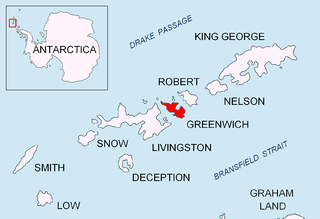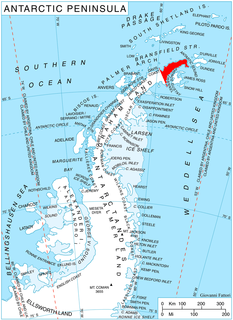
Thurston Island is an ice-covered, glacially dissected island, 215 km (134 mi) long, 90 km (56 mi) wide and 15,700 km2 (6,062 sq mi) in area, lying a short way off the northwest end of Ellsworth Land, Antarctica. It is the third largest island of Antarctica, after Alexander Island and Berkner Island.

Danco Island or Isla Dedo is an island off Antarctica, 2 kilometres (1 nmi) long lying in the southern part of Errera Channel, off the west coast of Graham Land. It was charted by the Belgian Antarctic Expedition under Adrien de Gerlache, 1897–1899. Danco Island was surveyed by the Falkland Islands Dependencies Survey from Norsel in 1955, and named by the UK Antarctic Place-names Committee for Emile Danco (1869–1898), a Belgian geophysicist and member of the Belgian Antarctic Expedition, who died on board Belgica in the Antarctic.

Coronation Island is the largest of the South Orkney Islands, 25 nautical miles (46 km) long and from 3 to 8 nautical miles wide. The island extends in a general east-west direction, is mainly ice-covered and comprises numerous bays, glaciers and peaks, the highest rising to 1,265 metres (4,150 ft).

Cape Longing is a rocky cape on the east coast of Graham Land, Antarctica, forming the south end of a large ice-covered promontory which marks the west side of the south entrance to Prince Gustav Channel. It was discovered by the Swedish Antarctic Expedition under Otto Nordenskiöld in 1902, and so named by him because from the position of his winter hut on Snow Hill Island the cape lay in the direction of his "land of longing" which he was anxious to explore.

Aagaard Glacier, also known as Glaciar Alderete, is an 8-mile (13 km) long Antarctic glacier which lies close to the east of Gould Glacier and flows in a southerly direction into Mill Inlet, on the east coast of Graham Land. It was charted by the Falkland Islands Dependencies Survey (FIDS) and photographed from the air by the Ronne Antarctic Research Expedition during December 1947; it was named by the FIDS for Bjarne Aagaard, a Norwegian authority on Antarctic whaling and exploration.

The Ibar Rocks are two rocks located 0.4 kilometres (0.2 nmi) east of Bonert Rock and 1 kilometre (0.6 nmi) southeast of Canto Point, Greenwich Island, in the South Shetland Islands. The names "Islote Ibar" and "Islote Teniente Ibar" appearing on Chilean hydrographic charts in the 1950s refer to the larger and western rock. The recommended name "Ibar Rocks" includes a submerged outlier to the northeast of the larger rock. Teniente (lieutenant) Mario Ibar P. signed the official act of inauguration of the Chilean Captain Arturo Prat Base on Greenwich Island in 1947.

Lambda Island is an island lying immediately north-west of Delta Island in the Melchior Islands, of the Palmer Archipelago in Antarctica. The island, the largest in the north-western part of the island group, was first roughly charted and named "Île Sourrieu" by the French Antarctic Expedition, 1903–05 under Jean-Baptiste Charcot, but that name has not survived in usage. The current name, derived from lambda, the 11th letter of the Greek alphabet, was given by Discovery Investigations personnel who roughly charted the island in 1927. The island was surveyed by Argentine expeditions in 1942, 1943 and 1948.

Andrew Glacier is a glacier 3 nautical miles (6 km) long, flowing northeast into Ognen Cove in Charcot Bay immediately west of the Webster Peaks on Trinity Peninsula, northern Graham Land. It was charted in 1948 by the Falkland Islands Dependencies Survey (FIDS) who named the feature for Dr. James Darby Andrew, medical officer at the FIDS Hope Bay station in 1946–47.

Cleft Island is a small island to the north of the Bølingen Islands, lying 5 kilometres (2.5 nmi) southeast of Lichen Island in southern Prydz Bay. The island is split by a deep channel about 6 metres (20 ft) wide. The island was plotted from air photos taken by the Lars Christensen Expedition, 1936–37, and called Lorten by Norwegian cartographers. The feature was visited by an Australian National Antarctic Research Expeditions party from the Nella Dan in February 1966 and renamed with reference to the deep channel.
Clifford Glacier is a broad glacier, about 40 nautical miles (70 km) long, flowing in an east-northeast direction to the gap between Mount Tenniel and the Eland Mountains, and then east to Smith Inlet on the east coast of Palmer Land. The upper part of this glacier was charted in 1936 by the British Graham Land Expedition under John Rymill; the seaward side by the United States Antarctic Service survey party which explored along this coast in 1940. During 1947 it was photographed from the air by the Ronne Antarctic Research Expedition under Finn Ronne, who in conjunction with the Falkland Islands Dependencies Survey (FIDS) charted it from the ground. It was named in 1952 by the FIDS for Sir G. Miles Clifford, at that time Governor of the Falkland Islands.

Dufayel Island is an island lying near the center of Ezcurra Inlet, Admiralty Bay, in the South Shetland Islands. It was charted and named in December 1909 by the French Antarctic Expedition under Jean-Baptiste Charcot.
Friederichsen Glacier is a glacier 7 nautical miles (13 km) long, which flows in an easterly direction into Cabinet Inlet, close north of Mount Hulth, on the east coast of Graham Land, Antarctica. It was charted by the Falkland Islands Dependencies Survey (FIDS) and photographed from the air by the Ronne Antarctic Research Expedition in 1947. It was named by the FIDS for Ludwig Friederichsen, a German cartographer who in 1895 published a chart based upon all existing explorations of the Antarctic Peninsula and the South Shetland Islands.

Gnomon Island is a small rocky island lying just north of Point Wild, on Elephant Island in the South Shetland Islands. It was charted by Ernest Shackleton's Endurance expedition, 1914–16, and so named by them because when viewed from Point Wild the shape of the feature is suggestive of a gnomon, the elevated arm of a sundial.

González Island is a small island on the south side of the entrance to Iquique Cove, Discovery Bay, Greenwich Island in the South Shetland Islands. On its west side the island is linked by a split to a smaller island, which is covered at high tide. The island was charted by the Chilean Antarctic Expedition of 1947, and commanded by Capitan de Navio Federico Guesalaga Toro, who named it after Ernesto González Navarrete, captain of the ship Iquique on the expedition.

The Gosling Islands are a scattered group of islands and rocks lying close south and west of Meier Point, off the south coast of Coronation Island in the South Orkney Islands of Antarctica. They were first charted and named "Gestlingen" by Petter Sorlle in 1912–13. This was corrected to "Gjeslingene" on a later chart by Sorlle. The approved name is an anglicized form recommended by the UK Antarctic Place-Names Committee.

Gourdin Island is the largest island (124 ha) in a group of islands and rocks 2 km (1 nmi) north of Prime Head, the northern tip of the Antarctic Peninsula. It was discovered by a French expedition, 1837–40, under Captain Jules Dumont d'Urville, and named by him for Ensign Jean Gourdin of the expedition ship Astrolabe. The island was reidentified and charted by the Falkland Islands Dependencies Survey in 1945–47.
Halfthree Point is a point forming the south-eastern end of Fildes Peninsula, King George Island, in the South Shetland Islands of Antarctica. It was charted and named by Discovery Investigations personnel on the Discovery II in 1935. It is part of the Fildes Peninsula Antarctic Specially Protected Area, designated as such because of its paleontological values.

The Moss Islands are a group of small islands and rocks lying east of Midas Island and north of Apéndice Island in Hughes Bay, off the west coast of Graham Land, Antarctica. They were first charted in detail and given the descriptive name "Moos Inseln" by the Swedish Antarctic Expedition under Otto Nordenskiöld in 1902.

Low Rock is a low rock surrounded by foul ground, lying 2 kilometres (1 nmi) southwest of Stranger Point, the southern extremity of King George Island, in the South Shetland Islands, Antarctica. An unnamed rock in essentially this position appears on a chart by David Ferguson, a Scottish geologist aboard the whaler Hanka, in these waters in 1913–14. Low Rock was more accurately charted by Discovery Investigations personnel on the Discovery II in 1935 and 1937.
Matthes Glacier is a glacier 9 nautical miles (17 km) long, flowing east into Whirlwind Inlet between Demorest Glacier and Chamberlin Glacier, on the east coast of Graham Land, Antarctica. It was discovered by Sir Hubert Wilkins on a flight of December 20, 1928, and photographed from the air by the United States Antarctic Service in 1940. It was charted by the Falkland Islands Dependencies Survey in 1947 and named for François E. Matthes, then chief geologist with the U.S. Geological Survey.














